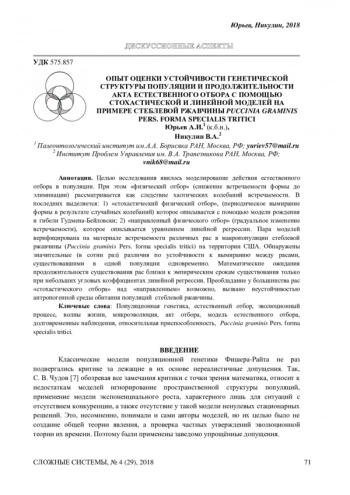Целью исследования явилось моделирование действия естественного отбора в популяции. При этом «физический отбор» (снижение встречаемости формы до элиминации) рассматривается как следствие хаотических колебаний встречаемости. В последних выделяется: 1) «стохастический физический отбор», (периодическое вымирание формы в результате случайных колебаний) которое описывается с помощью модели рождения и гибели Гудмена-Бейловски; 2) «направленный физического отбор» (градуальное изменение встречаемости), которое описывается уравнением линейной регрессии. Пара моделей верифицирована на материале встречаемости различных рас в макропопуляции стеблевой ржавчины (Puccinia graminis Pers. forma specialis tritici) на территории США. Обнаружены значительные (в сотни раз) различия по устойчивости к вымиранию между расами, существовавшими в одной популяции одновременно. Математические ожидания продолжительности существования рас близки к эмпирическим срокам существования только при небольших угловых коэффициентах линейной регрессии. Преобладание у большинства рас «стохастического отбора» над «направленным» возможно, вызвано неустойчивостью антропогенной среды обитания популяций стеблевой ржавчины.
The aim of the research is modeling the strength of natural selection on a population. In this context, “physical selection” (decrease in a form’s occurrence rate down to elimination) is considered to be the result of chaotic oscillations of the occurrence. The latter include 1) “stochastic physical selection” (recurrent extinction of a form due to random oscillations), which is predicted by the Goodman-Belovsky birth and death model, and 2) “directional physical selection” (gradual changes in the occurrence rate) described by the linear regression equation. The two models were verified using the data on the occurrence rates of different races within the macropopulation of stem rust (Puccinia graminis Pers. forma specialis tritici) in the United States. The extinction tolerance varied significantly (by a factor of hundreds) among the races which were present in the same population at the same time. Statistical lifespan expectations of the races were relatively equal to the observed lifespans only in case of small slope values of the linear regression. The prevalence of the “stochastic selection” over the “directional selection” in most races could be caused by instability of the anthropogenic environment of the stem rust populations.




